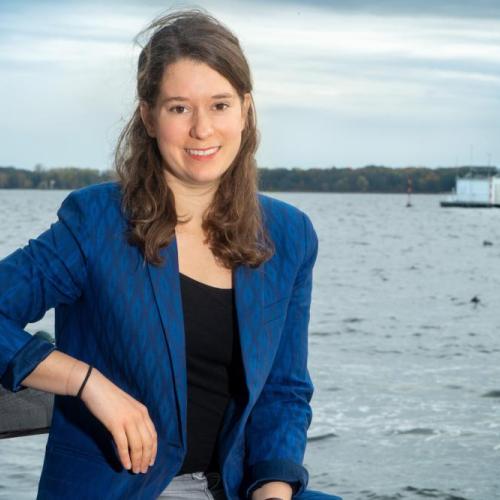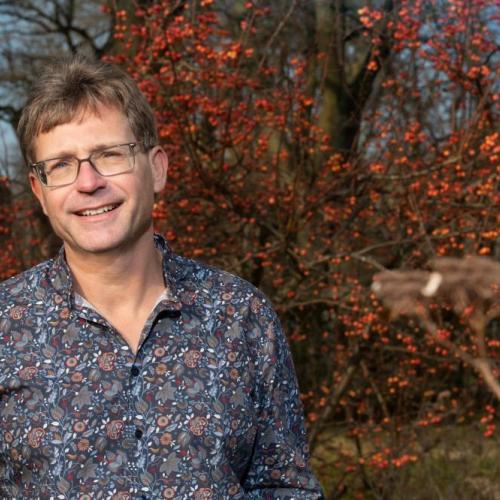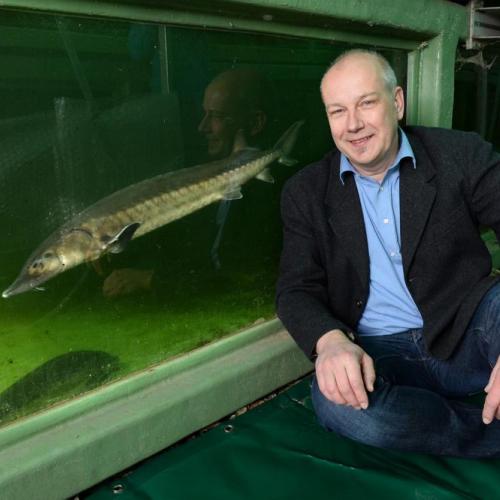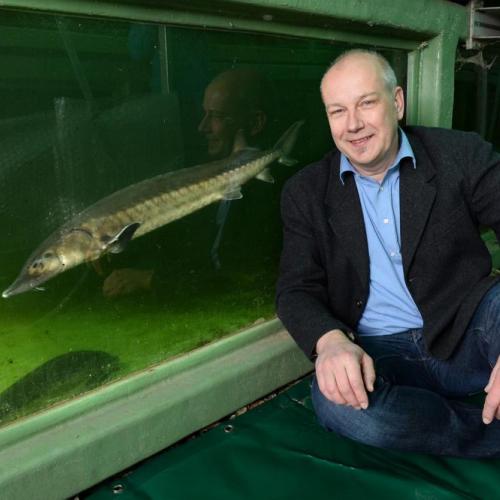
Riverine floodplains are some of the world’s hotspots for biodiversity, plant productivity and biogeochemical nutrient turnover. | © shutterstock 1073271503
© private
Humans have greatly impacted the environment. Is it at all possible to reverse these changes, Ms Heger?
No, but that is not the point. In fact, there are virtually no places left in the world where truly untouched nature can be found. There are no primeval forests in Germany, unregulated flow conditions in Europe’s rivers are almost non-existent, and anthropogenic climate change is affecting and altering all ecosystems throughout the world. Natural and man-made environments should therefore not be seen as polar opposites. All kinds of environmental states may exist between these two poles. An ecosystem in which humans intervene can be just as biologically diverse as a natural system, and in some cases it can even be more resilient – as successful restoration projects show. What we need, are new approaches to understand that everything we generally regard as “nature” has at some time been modified by humans, whether intentionally or not – and that this fact also implies a special responsibility. Contemporary restoration should therefore no longer have the stringent objective of restoring an environment to its “original state”, because this is rarely possible. Restoration should rather be understood as a process that follows specific fixed principles, but is sufficiently flexible to take into account the prevailing conditions.

© David Ausserhofer
One example of artificially created water bodies that are actually just a by-product of activities such as gravel or sand extraction are quarry ponds. How can these freshwaters be ecologically enhanced and their biodiversity promoted, Mr Arlinghaus?
As a matter of fact, this is a question we looked into in detail during our BAGGERSEE project. In our country, many quarry ponds are managed by angling clubs. These water bodies are usually nutrient-poor, with sandy unstable sediments and relatively steeply sloping banks. This is why the riparian zone, which is important for biodiversity, accounts for a small proportion of the total pond area in many quarry ponds. We teamed up with angling clubs to create shallow water zones at selected sites, and introduced bundles of deadwood, which can provide shelter and substrate for a variety of organisms. The shallow water zones are particularly conducive to increasing fish diversity; they also have multiple positive effects on other groups of organisms such as insect larvae and aquatic plants. Another important measure is the initial stocking of fish in quarry ponds, which is beneficial to fish species diversity. However, once a fish species community has become established, there is no need for fish stocking. At this stage, measures that enhance the structure of the riparian zone are then important for species richness.
© David Ausserhofer
Restoration does not automatically mean leaving ecosystems to their own devices. Mr Zak, you are investigating how peatlands can be restored from agricultural land. What are your recommendations?
Intact or undrained peatlands provide habitat for many rare or endangered animal and plant species, and are important sinks for greenhouse gases and nutrients. It is therefore right and important to ensure the rewetting of former peatlands. But that alone does not immediately create a functioning peatland: due to past drainage, surface soil layer has subsided and have become mineralised. After rewetting, shallow lakes with an average depth of up to one metre are often formed. We have discovered that this process can cause large amounts of methane and nutrients to be released into the environment. In such flooded peatlands, phosphorus concentrations in the soil water are 100 to 1,000 times higher than in near-natural peatlands. If rewetting causes the release of large quantities of nutrients, they may also end up in other adjacent surface waters. But some of these water bodies are characterised by species communities that are adapted to particularly nutrient-poor habitats. Then there is the risk that such biotopes will be over-fertilised. Much of the phosphorus and other water-polluting substances is present in mobile form in the uppermost 20 to 50 centimetres of drained peatlands, and can leach out, for example. In some cases, it therefore makes ecological sense to remove the highly mineralised topsoil before rewetting – especially in areas with somewhat steeper slopes and low groundwater levels. In such places, the drainage ditches are filled in with part of the removed soil, causing the water level to rise again naturally. With this method, peatland-typical vegetation can develop again within a few years. For this restoration measure to work, however, the groundwater level must be close to the soil surface. Another option is gradual rewetting. This is recommended in places where the technical conditions allow different barrages to be set. However, there is no universal recommendation: parameters such as topography, size, soil degradation, runoff, groundwater levels and current land use should be taken into account when selecting the appropriate method.

© David Ausserhofer
Mr Pusch, you focus on flowing waters and their floodplains. What are the positive effects of restoration, and what conditions must be met?
Riverine floodplains are some of the world’s hotspots for biodiversity, plant productivity and biogeochemical nutrient turnover. We humans therefore benefit greatly from their ecosystem services. Unfortunately, around 80 per cent of Germany’s rivers and floodplains have been significantly modified – for the benefit of a handful of uses, such as shipping and agriculture. This affects aspects such as biodiversity, self-purification from pollutants, resilience to climate change, and social recreational functions. At the start of the 21st century, we therefore began to shift flood protection barriers further back, enabling floodwater to spread out across larger floodplain areas and to prevent it from reaching disastrous levels. The floodplains reclaimed in this way are simultaneously valuable drinking water reservoirs and have other important regulatory functions, which is why they are also referred to as blue-green infrastructure. In two international flagship projects on behalf of the European Commission, we will investigate how river and floodplain restoration can be accelerated – for example, by involving local actors in the development and implementation of restoration projects. Other approaches include mitigating conflicts of interest by accounting for ecosystem services, or promoting business models based on the sustainable and extensive use of restored land.
© Andy Küchenmeister
Nonetheless, in the face of drought and low water levels, artificial damming and regulation are still being mooted as potential solutions. Why is this the completely wrong approach, Mr Wolter?
Because it comes at the expense of the adaptability and resilience of rivers to the effects of climate change. Flowing waters are subject to natural dynamics of annual periods of high and low water levels. The straightening and regulation of watercourses lead to faster water runoff and sediment transport. Regulating structures and revetments prevent lateral erosion, making rivers deeper and draining the landscape even more during low flows. Until now, technical flood protection with dykes has primarily focused on dissipating floodwaters as quickly as possible to prevent flooding. All this produces higher flows to the detriment of natural water retention in the landscape and essential groundwater storage. Consequently, phases of low water levels start earlier and last longer in regulated rivers – bringing drought to the entire river basin. This process must be stopped and reversed. To make rivers fit for climate change, such artificial interventions should therefore be dismantled as far as possible or, where this is genuinely not possible, made more ecologically compatible. Natural flood control and water retention processes in the landscape should be revitalised, and flooding zones and tributaries reactivated. Although artificial damming holds back water locally to a limited extent, it fails to enhance natural processes in the river basin. What is more, it promotes evaporation, retains sediments, which are lacking as habitat structures downstream, and even contributes to depth erosion and landscape drainage in their tailwater, i.e. downstream of the structure.

© David Ausserhofer
Ms Wiebe, you address urban waters, which are particularly exposed to multiple stressors and influencing factors and are usually heavily modified. How can we bring about ecological improvements to heavily built-up inner-city watercourses?
It is easy to underestimate or overlook the ecological potential of heavily built-up water bodies because they differ so greatly from near-natural freshwaters. And yet these possibilities should be taken seriously and exploited – even if measures can only be implemented on a small scale. To achieve this, we must view water bodies in terms of their function as a habitat for aquatic organisms, and enhance them accordingly. This includes creating the riparian structures and vegetation types that have disappeared from vertically stabilised banks, e.g. due to sheet piling. The vegetation belt at the water’s edge is a key element for its aquatic community, because this is where fish, insects, birds and mammals find shelter, food and places to rear their broods – functions that sheet piling lacks. Moreover, exposed dark steel sheet piling heats up considerably on hot, sunny days, and transfers this heat to the water. This is why in the “Vertical Wetlands – Vegetated sheet pile as potential ecological areas along inner-city waterways” project we are investigating how a system of plant boxes on sheet piling can lead to an ecological improvement by artificially recreating elements of a natural bank. Our project partner, the WITE company, designed a planting system for this purpose, which is now being implemented on a Berlin waterway on a trial basis and scientifically monitored by IGB.

© David Ausserhofer
Small bodies of water are also often underestimated. Mr Mehner, how can ponds, pools and puddles be preserved, and why is it important do to so?
Small standing waters help to retain water in the area; they have a positive impact on the microclimate; they act as important areas of refuge and stepping stone biotopes for endangered species; and provide us with valuable recreational areas, especially in urban spaces. They are often fed by near-surface backwater that forms above impermeable, deeper soil layers, or by groundwater. Both sources make them particularly vulnerable to declining rainfall and groundwater levels in the surrounding landscape. Measures should therefore be taken to ensure the minimum ecological water requirements of small water bodies, such as large-scale percolation of rainwater and treated wastewater to retain water in the landscape. Moreover, these water bodies are located in landscape depressions, causing material flows to accumulate there. In intensive agriculture, fields are sometimes extended into the immediate riparian areas of water bodies. As a result, there are no buffer zones to protect against inputs of field sediments, fertilisers, herbicides, fungicides and insecticides. This must change, for example by providing adequately sized riparian buffer strips that act as a material barrier and reduce hazardous inputs to water bodies by means of retention or chemical transformation.

© David Ausserhofer
Mr Gessner, you have been working on the reintroduction of European and Baltic sturgeon into the Elbe and Oder rivers for more than two decades. In your experience, what are the obstacles involved when politically agreed restoration goals meet practical implementation on the ground?
The reintroduction of migratory fish populations or the restoration of ecologically functional habitats competes with a multitude of uses, such as navigation, agriculture, technical flood protection, building development, hydropower and, to some extent, recreation. This is particularly the case for large flowing waters. In the past, the objectives of river maintenance were determined one-dimensionally by economic benefits, which contributed to the loss of biodiversity in rivers and their floodplains. Even today, the management of waterways by the federal shipping authorities continues to exhibit massive shortcomings and failures with regard to the implementation of the European Water Framework Directive (WFD) and the establishment of protected areas within the European Habitats Directive (HD). This policy also stems from a lack of prioritisation and harmonisation of various directives and strategies from different policy fields, which are often in direct conflict with each other’s objectives. Consequently, “soft” and vague goals are often included in environmental programmes, which means that there is no effective possibility of sanctions if these goals are not met. In order to effectively tackle the biodiversity crisis and the consequences of climate change, it is no longer enough to simply regulate uses and interventions. There is an urgent need for integrative solutions that can, and in some cases must, also be accompanied by restrictions – for example on traffic use. If we want to give nature sufficient space to develop, enhance the resilience of ecosystems and also ensure that society benefits from these measures, we should attach importance to the spatial coupling of water bodies and their floodplains, as well as their large-scale flooding and the restoration of important habitats.









